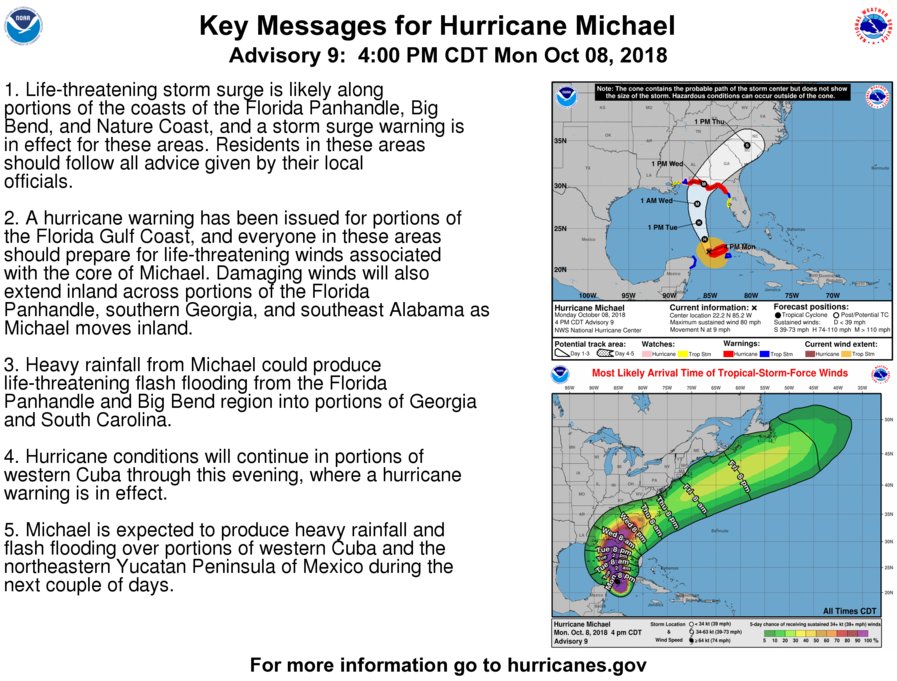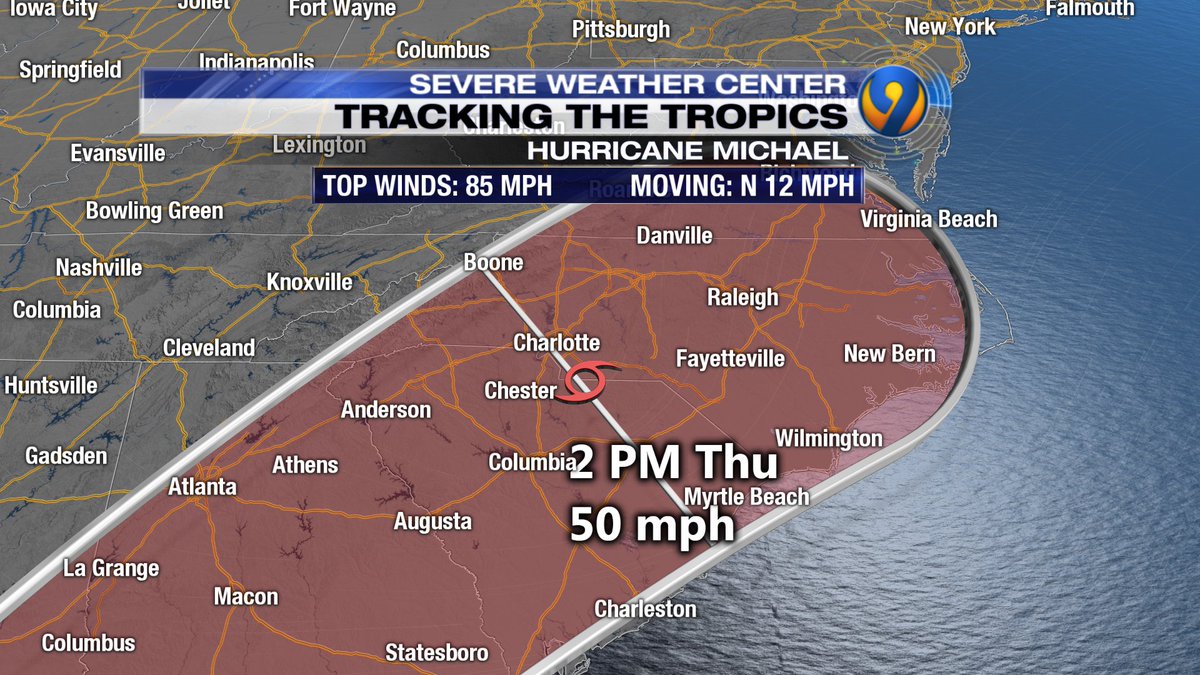You are using an out of date browser. It may not display this or other websites correctly.
You should upgrade or use an alternative browser.
You should upgrade or use an alternative browser.
Michael.
- Thread starter Greenbacks
- Start date
Michael is now forecast by the National Hurricane Center to reach Category 4 strength as it heads towards the Florida Panhandle. 0 Category 4-5 hurricanes on record (since 1851) have made landfall in the Florida Panhandle.
Packing 145 mph winds
tell that to the people that lost everything they owned
Yea no shit...
Here we go again...
[h=1]Why Hurricane Michael is a monster like no other[/h]
[FONT="]Even those jaded by hurricanes have never seen anything like this.[/FONT]
[FONT="]For the first time, a Category 4 hurricane is on track to slam the Florida Panhandle. And it's bringing an onslaught of deadly hazards.[/FONT]
[FONT="]Track Hurricane Michael[/FONT]
[FONT="]"Unfortunately, this is a hurricane of the worst kind," said Brock Long, head of the Federal Emergency Management Agency.[/FONT]
[FONT="]Here's what makes Hurricane Michael especially dangerous:[/FONT]
[h=3]The Panhandle could see its strongest hurricane ever[/h][FONT="]Michael rapidly intensified to a Category 4 hurricane overnight. By Wednesday morning, it was hurling 145-mph winds.[/FONT]
[FONT="]Even scarier, Michael could get stronger before making landfall Wednesday afternoon.[/FONT]
[FONT="]The storm will likely bring "winds that are above typical building codes," Long said.[/FONT]
[FONT="]Hurricane Andrew in 1992 inspired tougher building codes in Florida. But many older houses aren't built to withstand a beast like Michael.[/FONT]
[FONT="]"You're going to see roofs off houses. You're going to see houses collapsing," said Ken Graham, director of the National Hurricane Center.
[/FONT]
[h=3]Pine trees could become flying weapons[/h][FONT="]Florida's Panhandle is covered with thousands of pine trees. And with winds topping 140 mph, those trees could turn into violent projectiles.[/FONT]
[FONT="]"You get those kinds of winds, it's catastrophic damage to the trees' structure," Graham said.[/FONT]
[FONT="]And with downed trees come power outages.[/FONT]
[FONT="]"This could bring down thousands and thousands of those pine trees here -- not only making all the damage along the coast but inland as well," CNN meteorologist Chad Myers said.[/FONT]
[FONT="]Graham said because this storm is "absolutely overwhelming," power outages could last weeks.[/FONT]
[h=3]Storm surges could be deadly[/h][FONT="]Michael will spawn massive storm surges -- or walls of ocean water -- as high as 14 feet, forecasters said.
[/FONT]
[FONT="]"Half of the fatalities in these tropical systems occur with the storm surge," Graham said.[/FONT]
[FONT="]The FEMA chief said anyone asked to evacuate needs to do so immediately.[/FONT]
[FONT="]"This is nothing to play around with," Long said. "Those who stick around and experience storm surge are less likely to live to tell about it."[/FONT]
[h=3]Cities far inland will feel an actual hurricane[/h][FONT="]Many hurricanes sputter out after they hit land and lose the title of hurricane. But not Michael.[/FONT]
[FONT="]Michael will keep plowing through the Southeast as a hurricane, with winds topping 73 mph as it crosses into Georgia.[/FONT]
[FONT="]"Because of the forward movement -- the decent forward movement it has -- you're going to see a hurricane stay intact through southwest and central Georgia," Long said.[/FONT]
[FONT="]"And then you're going to see rainfall through South and North Carolina, dumping 4 to 6 inches of rain in rivers that are already saturated and haven't really receded much from Florence a few weeks ago."[/FONT]
[h=3]The hurricane could spawn tornadoes, too[/h][FONT="]As if one cyclone weren't enough, Hurricane Michael could cause tornadoes in several states.[/FONT]
[FONT="]"A few tornadoes will be possible across parts of the Florida Panhandle and the northern Florida Peninsula through this afternoon," the National Hurricane Center said Wednesday.[/FONT]
[FONT="]"This risk (of tornadoes) will spread into parts of central and southern Georgia and southern South Carolina this afternoon and tonight."[/FONT]
[FONT="]Hurricanes are good at producing tornadoes because they cause a lot of vertical shear -- or differences in wind direction and speed at different heights.[/FONT]
[FONT="]And the risk of tornadoes is far-reaching. Most tornadoes spawned by tropical cyclones strike about 50 to 200 miles from the hurricane's center, the National Oceanic and Atmospheric Administration said.[/FONT]
[FONT="]Even those jaded by hurricanes have never seen anything like this.[/FONT]
[FONT="]For the first time, a Category 4 hurricane is on track to slam the Florida Panhandle. And it's bringing an onslaught of deadly hazards.[/FONT]
[FONT="]Track Hurricane Michael[/FONT]
[FONT="]"Unfortunately, this is a hurricane of the worst kind," said Brock Long, head of the Federal Emergency Management Agency.[/FONT]
[FONT="]Here's what makes Hurricane Michael especially dangerous:[/FONT]
[h=3]The Panhandle could see its strongest hurricane ever[/h][FONT="]Michael rapidly intensified to a Category 4 hurricane overnight. By Wednesday morning, it was hurling 145-mph winds.[/FONT]
[FONT="]Even scarier, Michael could get stronger before making landfall Wednesday afternoon.[/FONT]
[FONT="]The storm will likely bring "winds that are above typical building codes," Long said.[/FONT]
[FONT="]Hurricane Andrew in 1992 inspired tougher building codes in Florida. But many older houses aren't built to withstand a beast like Michael.[/FONT]
[FONT="]"You're going to see roofs off houses. You're going to see houses collapsing," said Ken Graham, director of the National Hurricane Center.
[/FONT]
[h=3]Pine trees could become flying weapons[/h][FONT="]Florida's Panhandle is covered with thousands of pine trees. And with winds topping 140 mph, those trees could turn into violent projectiles.[/FONT]
[FONT="]"You get those kinds of winds, it's catastrophic damage to the trees' structure," Graham said.[/FONT]
[FONT="]And with downed trees come power outages.[/FONT]
[FONT="]"This could bring down thousands and thousands of those pine trees here -- not only making all the damage along the coast but inland as well," CNN meteorologist Chad Myers said.[/FONT]
[FONT="]Graham said because this storm is "absolutely overwhelming," power outages could last weeks.[/FONT]
[h=3]Storm surges could be deadly[/h][FONT="]Michael will spawn massive storm surges -- or walls of ocean water -- as high as 14 feet, forecasters said.
[/FONT]
[FONT="]"Half of the fatalities in these tropical systems occur with the storm surge," Graham said.[/FONT]
[FONT="]The FEMA chief said anyone asked to evacuate needs to do so immediately.[/FONT]
[FONT="]"This is nothing to play around with," Long said. "Those who stick around and experience storm surge are less likely to live to tell about it."[/FONT]
[h=3]Cities far inland will feel an actual hurricane[/h][FONT="]Many hurricanes sputter out after they hit land and lose the title of hurricane. But not Michael.[/FONT]
[FONT="]Michael will keep plowing through the Southeast as a hurricane, with winds topping 73 mph as it crosses into Georgia.[/FONT]
[FONT="]"Because of the forward movement -- the decent forward movement it has -- you're going to see a hurricane stay intact through southwest and central Georgia," Long said.[/FONT]
[FONT="]"And then you're going to see rainfall through South and North Carolina, dumping 4 to 6 inches of rain in rivers that are already saturated and haven't really receded much from Florence a few weeks ago."[/FONT]
[h=3]The hurricane could spawn tornadoes, too[/h][FONT="]As if one cyclone weren't enough, Hurricane Michael could cause tornadoes in several states.[/FONT]
[FONT="]"A few tornadoes will be possible across parts of the Florida Panhandle and the northern Florida Peninsula through this afternoon," the National Hurricane Center said Wednesday.[/FONT]
[FONT="]"This risk (of tornadoes) will spread into parts of central and southern Georgia and southern South Carolina this afternoon and tonight."[/FONT]
[FONT="]Hurricanes are good at producing tornadoes because they cause a lot of vertical shear -- or differences in wind direction and speed at different heights.[/FONT]
[FONT="]And the risk of tornadoes is far-reaching. Most tornadoes spawned by tropical cyclones strike about 50 to 200 miles from the hurricane's center, the National Oceanic and Atmospheric Administration said.[/FONT]
Be safe all.
Live weather channel









